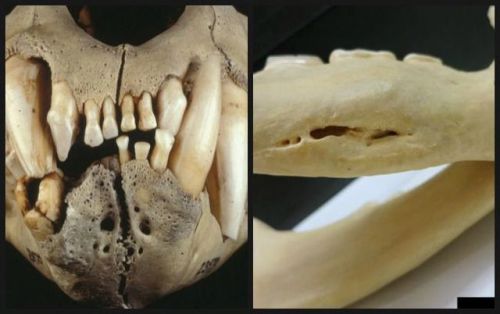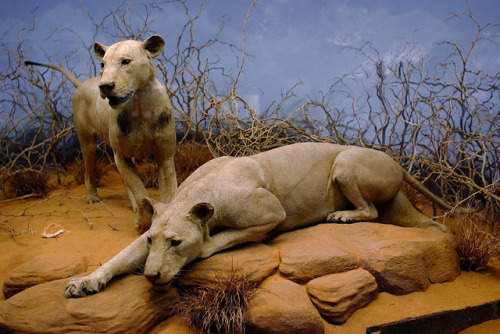megarah-moon:The Real ‘The Ghost And The Darkness’In 1996 moviegoers’ evolutionary ancestral fear of
megarah-moon:The Real ‘The Ghost And The Darkness’In 1996 moviegoers’ evolutionary ancestral fear of humans being prey to an apex predator was put on display in the film ‘The Ghost and the Darkness’, a historical action horror film that starred Val Kilmer as Lt. Colonel John Henry Patterson. Kilmer’s character goes to Tsavo, Kenya to help a railroad company with a “Wild Life” problem where workers are being attacked by two Lions. After arriving and encountering the Lions himself, he soon discovers that these Lions are not normal and are bloodthirsty and go on a kill/eating spree. Towards the end of the film, Kilmer’s character gets ’s help from Michael Douglas’s character, Charles Remington, a professional large game hunter, and the two discover that the lions are killing for sport. Fast forward to the end, Kilmer solves the problem and the railway is complete.As it was mentioned at the end of the film, the Lions of Tsavo can be seen today at the Field Museum in Chicago. Though the movie is pretty entertaining (I’m actually a fan of it) the historical part of the story is a little less dramatic as the film shows. The lions on display are named, the one standing is FMNH 23969 and the one crouching is FMNH 23970. Their appearance is odd for two reasons, the lions are indeed adult males but they’re Maneless, a feature that’s typical in the Lion population in Tsavo, and the lions for a long time after their deaths were used as carpets by Patterson himself. The process of making an animal into a carpet results in a lot of the skin being removed, so when the lions were put on display they had to use skins from other lions to patch them together.In 1898 the English were building a rail bridge over the Tsavo River as part of a new railway connecting Uganda to the Indian Ocean. Unlike the film, Patterson was not brought in to help with the lion problem, Patterson was already at the work site, in short, he was in charge of the project. After the project started, the two lions came and their odd behavior began. Workers were pulled out of their tents at night and dragged away from camp and were eaten. This became a pattern that would repeat many times. Patterson dealt with the problem head on and helped the workers try to set up deterrents to keep the lions away. These did not work; the Lions still came and attacked. Because of this, many workers left the site forcing Paterson to actively go and hunt the lions. For a while it was a (big) cat and mouse game, Patterson set up traps, the Lions avoided them, he would ambush them but they escape.Finally, Patterson was able to kill the first lion (FMNH 23970) on December 9th with two shots from a high powered rifle. The second lion (FMNH 23969) was killed December 29th after being shot nine times from three different rifles, all shot by Patterson. After killing the lions, work on the bridge resumed and it was finished in March of 1899 but the mystery of the Man-eaters of Tsavo still baffled Patterson and experts to this day, even after discoveries were made thanks to the skulls of the man-eaters.When one looks at the skulls of the lions, you may notice something a bit off about both of them. FNHM 23969’s bottom right canine is broken but Patterson wrote that he struck one of the lions with his rifle when it tried to attack him. Then there’s FNHM 23970, he’s missing some bottom teeth which are common in some lions, they get kicked in the face by hoofed animals and get teeth knocked out but his canine and the bone tissue surrounding it’s lower teeth show signs of an abscessed tooth or severe infection in the roots of its teeth; he was in pain and could not bite hard.This is the most common and accepted theory, one of two lions was incapable of killing its normal prey, lions strangle their prey by applying a strong bite on the throat of its prey but if you have a painful infection, it means you have to bite on something, “softer”. Recent analytical-studies of the Isotopic Signature of the two lions, scientists were able to figure out how many people were eaten by each lion and it’s estimated that both lions ate 35 workers, about 100 less than what Patterson recalled but these figures only mean those who were eaten, not just killed. FNHM 23969 ate 10.5 humans and FNHM 23970 (the one with the infected teeth) ate 24.2 humans. Further studies done on the later lion’s teeth looking at dental microwear texture have noticed that the wear on FNHM 23970’s teeth shows the same type of wear that is seen in captive lions who eat a “soft” diet and don’t bite on bones.In theory, the strange behavior by the two lions is the result of possibly a perfect storm of circumstances. As mentioned above, the one lion losing the ability to kill larger prey, the time of year that most of the attacks seemed to have occurred, winter, or in Africa, the dry season. Lions can become desperate at this time as many large prey move on as water becomes scarce. Finally, a massive outbreak of Cattle Plague (Rinderpest) thinning out the number of natural prey. All these could have been the collective result of why these two lions acted the way they have, nature responding to nature, not some nefarious act carried out by a couple “rogues”.Patterson went on to recount his encounters with the lions in his book ‘The Man-eaters of Tsavo’ which eventually inspired the film ‘The ghost and the darkness’ the title of the film plays on the names that Patterson gave the two lions in his book, one lion called “The Ghost” and the other “The Darkness” since the two lions came and went in the night like ghosts. Patterson did eventually return to Tsavo for a hunting trip and inadvertently discovered a new species of Eland (a type of antelope) which was later named after him, The Eastern eland or Patterson’s Eland. -- source link





